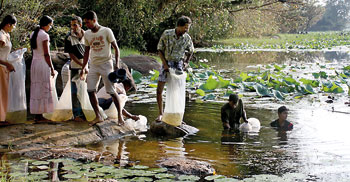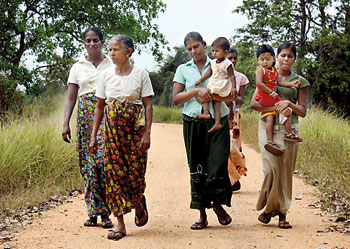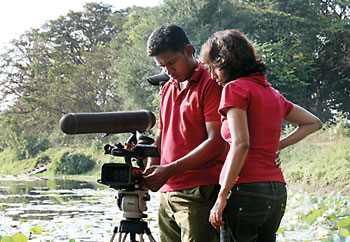A light breeze gently ruffles the olu and nelum dotting the wewas in the Dry Zone and children laughingly dive in, sending up a cloud of white spray. Ancient villages revolved around the temple and the wewa and still do and this inextricable link is the focus of a 30-minute documentary that will be beamed to your living room on June 23.
 |
 |
| Villagers release fish into the wewa and village women on the way to a farmers’ meeting |
Travelling through the remote Dry Zone, specifically to Maha Wilachchiya, Nuwaragam Palatha Central and Medawachchiya divisional secretariat divisions with notebook in hand and camera crew in tow, well-known film-maker Anoma Rajakaruna has gone from one tank to the next in 47 villages to portray how crucial these tanks are for the very existence of humans.
Culminating in ‘When water decides the way of life….’, Anoma, sociologist and international award-winning film-maker with 35 documentaries to her credit, calls her efforts a “participatory evaluation of a small tank rehabilitation project” implemented by Plan Sri Lanka from 2004 to 2010. The evaluation has been carried out not only by talking to the villagers themselves but also picking the brains of Emeritus Prof. C.M. Madduma Bandara about the rites and passages linked to water and farming.
An interesting nugget of information that most people may not know is that the man-made tanks in the North Central Province operate on a “cascade” or “cluster” system.
Although Anoma and her crew have captured 28 tanks in five cascades rehabilitated under the project, Emeritus Prof. Madduma Bandara, a son of the soil from Anuradhapura and expert on water and land, who is the narrator opens a window to the past and the skills of the ancients when he discloses that the Dry Zone has 30,000 tanks in all, of which half remain unused today. The simplicity fascinates………..it was humble earthen dams across the streams which allowed the storage of water mainly for paddy cultivations and also for many other activities which saw villages flourishing and thriving.
Taking the viewer back to the time of the ancients and how their engineering feats helped overcome issues like salinity which would have had an adverse impact on paddy cultivation, Prof Madduma Bandara gets into the technicalities about the kumba horowwa and the kotang horowwa.
Even now numerous are the uses of the wewas, not only for irrigation but also for other livelihoods such as fishing and brick-making, while also providing easy accessibility to precious water for the daily needs of the villagers.
 |
| Anoma filming at Medawachchiya |
Another positive aspect of this documentary done by a woman herself is the voices of women which come loud and clear. After dealing with a 30-year conflict, many of the responsibilities not only within the family home but also the village are borne by the women. With the men falling victim to the conflict or going in search of “other” jobs the women have taken up the role of farmer, whereas earlier they only helped their spouses. They are also heavily involved in cleaning and maintaining the irrigation canals.
The lessons too are aplenty – the need to grow trees if the water source is to be protected but most of all the fact that the effects of climate change could very easily be offset by safeguarding this “hand-down” from our hydraulic civilization.
The simple but important message of the documentary is that these “oases” in a dry landscape are an invaluable tool in meeting the threats to humans by climate change.
The Sinhala version
The Sinhala version of ‘When water decides the way of life…’ will be telecast at 6.30 p.m. on June 23 over Rupavahini while the English version is scheduled to be shown over Channel Eye the following week.
The Editor of the documentary, which is a Plan Sri Lanka Production, is Rashika Dinesh Dharmaraja while the videographers are Asanka Dharmawardhana and Anuradha Jayasuriya.
|




